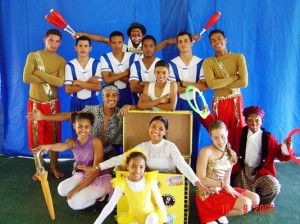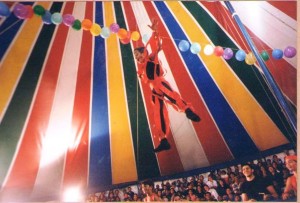Eighteen years ago a true revolution in the Brazilian educational system was started when Project Âncora launched in the town of Cotia, São Paulo. It took the form of a space for learning, practising and enhancing principles of citizenship with the aim of developing and transforming the reality of the local community. Since 1995 this non-profit project has catered to over 6,000 children, teenagers and their families through extracurricular activities such as music classes, theatre-circus, crafts and professional courses.
In 2012 an old dream was accomplished with the opening of the Project Âncora School of Infant and Primary Education. Following the methods of Escola da Ponte from Portugal, which challenges the traditional concept of education and the world’s prevalent standard model of schooling, the Project Âncora School follows an “educational philosophy which proposes that self-knowledge and experience are the key tools for learning, centred around the learner, his or her particularities and his or her transition from heteronomy to autonomy”.
Around 300 children and teenagers attend the school, which is structured round three parallel curricula: the individual, the social and the communal. This innovative model was inspired on democratic education and has been implemented in Brazil with the help of Portuguese language teacher José Pacheco, who has been known worldwide for having created the Escola da Ponte (School of the Bridge) in Portugal by making use of a revolutionary methodology. Marusia Meneguin, author of the blog Mãe Perfeita, has been enthralled by the original proposal:
Imagine a school without classrooms, schedules or exams. A curriculum which is decided upon by the children, through consensus, and which includes subjects such as circus and meditation. There is neither roll call nor punching the clock, and yet no absences on the part of pupils or teachers. Everything is free of charge. Now, imagine that these students come from violent environments and have been expelled from several schools. It may seem like utopia. Until the day when you get to know the proposal for the Escola da Ponte.
In an interview with G1, Pacheco states that education in Brazil, whose model ignores the contribution given by Paulo Freire and other great educators from the country, squanders resources and produces 30 million illiterate people. The results achieved by means of the alternative model, on the other hand, become visible within the community itself:
The former pupils from the School of the Bridge – some who are now over 50 years old – are living proof of the good quality of the project. They are fulfilled human beings who display a high level of civic awareness, are ethical, entrepreneurial, supportive of others. I should add that the Bridge welcomes pupils who are discarded by other schools, and recovers them. Pupils who do not learn in another school or pupils who put teachers is a state of shock in other schools, they come to the Bridge.
Whereas School of the Bridge has been in existence for nearly 40 years, the results of Project Âncora School in Brazil, which is just over a year old, will take a bit longer to become obvious. Nevertheless, the project has already attracted attention and has inspired other schools, receiving visits from educators from different parts of the country. After one of these visits, Talita Morais described the differences she finds in this utopic educational model:
The big difference of Project Âncora, as well as of the School of the Bridge in Portugal, is that the children are made conscious of the collective perspective, of respect and love for others, and of the value of autonomy in the pursuit of his or her studies. This way, going through the different levels – since there is no division by classes or grades in the school – the pupils gradually become more autonomous in their learning process, choosing what, how and at which moment they learn a certain subject, all done with the aid and orientation of teachers and tutors, who are made up of the schools personnel as well as volunteers from the community itself. Besides such autonomy surrounding the choice of study, they also take an active part in the decisions and management of the school by means of weekly assemblies which redefine the rules that guide the institution.
Teacher Fernanda Rodrigues compared the Âncora with other traditional schools:
There, we were welcomed by a very lively and talkative 11-year-old girl! She told us that she had been studying there since she was born and it became clear how truly proud she was for being part of the day-to-day life of Âncora. Her eyes shone and it became clear there was a deep feeling of belonging that the student holds in relation to everything that happens there.
It is worth saying as well that it is impossible not to become enchanted by the place, which is not only broad, but also inspires education in its greatness. We could witness several episodes which are not very common to find in traditional schools, such as boys taking care of the place, bags hanging on the entrance of the school, notice board displaying the agenda for the assembly and many people talking without giving way to that sort of screaming which is so commonly found in school environments.

Since 1995 this non-profit project has catered to over 6,000 children, teenagers and their families through extracurricular activities such as music classes, theatre-circus, crafts and professional courses. Photo from Facebook.
The next step of the project is to expand this experience beyond the walls of the institution and reach the whole town by integrating the pupils into “learning communities”. Once a week, the pupils must visit communal places, such as public health clinics and churches, in order to study local issues and talk directly with the residents. Following Pacheco’s formula, called “MC² – change enhanced by contamination and context”, the pupils must grab hold of the reality of the place where they live and seek solutions for the issues that they confront:
Learning communities are communal praxis based on an educational model that generates sustainable development. It is the expansion of the educational practices of Project Âncora beyond its walls, and which actively involves the community in the consolidation of a participative society.
When Project Ãncora turned 18 years old in October 2013, João Carlos, from the blog Soliarte, declared that a dream that has become reality “reached adulthood a long time ago”:
A new Brazil is born. Hail! Hail!
Thank you Pacheco for the silent revolution which is taking place in Brazilian education.
Not only the children benefit from this revolutionary model of education. As she recalled the anniversary celebrations, volunteer educator Johana Barreneche-Corrales pondered the importance of the playful and the emotional ties between the teacher:
Lastly, we may think that for a project to be successful, there is the need for a team to be put together, and that the team be truly a team, not by the number of people who join it, but by the strength of the ties between its members.
Project Âncora was one of the alternative education schools in Brazil that were visited by the documentary team Quando Sinto Que já Sei, a film made financially possible by means of crowdfunding through the website Catarse and which shall be launched in the beginning of 2014. The objective is to start a discussion about the present state of education in Brazil by exploring new ways of learning based on children’s participation and autonomy, values which are emerging and being put into practice throughout the country.
This article was written by Paula Góes in Portuguese and translated into English by Elisa Thiago. It originally appeared on Global Voices.
Tags: Activism, Research & quality, Trends

